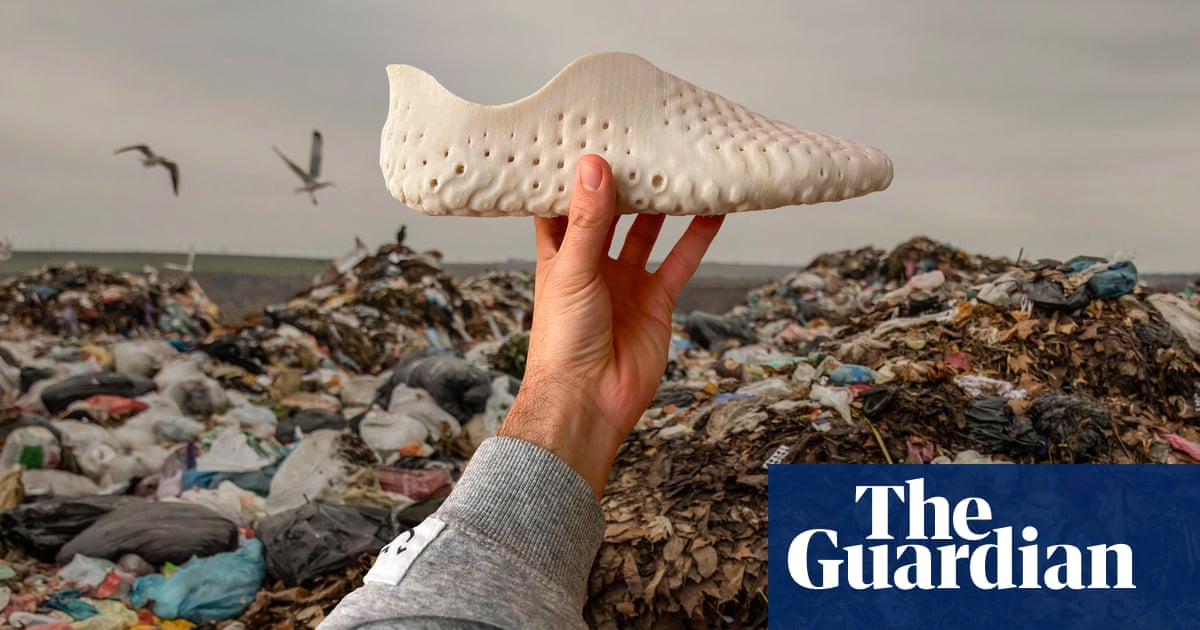The shoes may not immediately strike you as the future of mainstream fashion. Pale and porous, they resemble a cross between a beige Croc and the long-net stinkhorn fungus found on forest floors. Their creators, however, hope this will be the next huge breakthrough in sustainable footwear: the world’s first 3D printed, made-to-measure, compostable shoe, which can be broken down at the end of its life, in an attempt to stem the flow of millions of shoes into landfill each year.
Fashion is among the world’s top polluting industries. It is responsible for about 10% of global carbon emissions and consumes huge amounts of water and land for production. Modern shoes are among the hardest items to produce sustainably because of their complexity, say industry experts, and there are few reliable statistics about the number manufactured every year for the world’s 8 billion humans. There is an almost total dearth of statistics about their environmental impact.
Most shoes are composed of a mixture of synthetic fabric, rubber, plastic and metal, which is often held together with strong adhesives, and they are incredibly difficult to dispose of. The vast majority are bound for landfill once used, where they could take hundreds of years to break down. There are efforts to pioneer recyclable trainers for the world’s $70bn (£55bn) industry, with some brands offering services if customers post back.
To produce its new compostable model, the London-based shoe company Vivobarefoot has joined forces with a material science company, Balena, to create prototypes of the shoes, which are not yet available for sale. They will be manufactured based on in-store foot scans and then printed over 30 hours. Once they have worn down, the footwear can be returned for composting at an industrial facility, breaking down the patented material into a non-toxic substance.
“We are trying to build a regenerative footwear business in an industry that is pretty famous for exploration, extraction and short-termism,” says Asher Clark, a co-founder of Vivobarefoot. “This is about reimagining the way things are done from linear, offshore production to the world’s first scan-to-print-to-soil footwear. It is a vision for cutting out a lot of waste in supply chains and providing an end of life solution for the footwear industry.”
There are caveats to the sustainability claims of the shoes, says Clark, which will be sold for between £200 and £260. BioCir flex, the patented thermoplastic used to make them is 51% biological materials, 49% petrochemical. It cannot be thrown on a compost heap at the end of the garden to break down – it needs to go to a composting plant. Clark says its durability is similar to other polymers used to make trainers, but that there is work to be done on its grip.
“There is a trade-off between the biodegradability and durability: that is the key tension. The external factors that break down physical products are things like light, heat and moisture,” he says. “The challenge is to make a shoe that will handle all those elements but also respond to the elements that start to break it down at the end of its life.” The two companies will keep working to improve the design during the trial.
Glue and other binding materials can make shoes difficult to recycle, even when new substances are used for their main components, such as cactus “leather” – a material made from the leaves of the nopal cactus – and grape-skin derivatives, says Luca Mosca, fashion lead at the sustainability consultancy Quantis. He says it is still hard to say what constitutes an environmentally friendly shoe, and that consumers should use them for as long as possible.
“It is not an easy question. We have to look into all stages of a product lifecycle, the materials within the product. Here, there are a lot of differences: it could be a performance-driven shoe mostly made of synthetics, or a casual shoe made of leather. Then you need to look at the environmental performance of the materials and the production processes of putting the shoes together. Last but not least, you must look at how it will be treated at the end of life. Shoes are very complicated products,” says Mosca.
New alternative materials such as cactus leather are an important step forward, says Mosca, but cannot be produced in large quantities and don’t have all the attributes of animal leather.
“It’s a good first step but it does not represent a solid alternative to be produced at scale. With all the criticisms of leather, it is very durable and it can be repaired,” he says.
Polly Lythall, a business development manager for the non-profit British Footwear Association, says shifting manufacturing bases to China and India has increased the cost of more sustainable options. She says that despite the rise of new materials, leather’s durability and reparability still make it a strong option.
Probably one of the most sustainable pieces of footwear, she says, is still a high quality, well-made leather shoe. “You can have it resoled and the leather can be repaired,” Lythall says. “There is a lot of research into other material such as banana skins and coconut skin but, ultimately, leather is a by-product of the meat industry and it would go to waste. But the majority of people could not afford the cost [of those high-quality shoes],” she says.
“Most vegan materials, if you look at them, have far more oil in them and they’ve probably been imported from China. Our members and partners are finding it really difficult to navigate because there are no regulations. There is nothing that says if you want to classify a shoe as being sustainable, it has to have X, Y or Z. There’s nothing. It’s a really difficult subject,” says Lythall.












